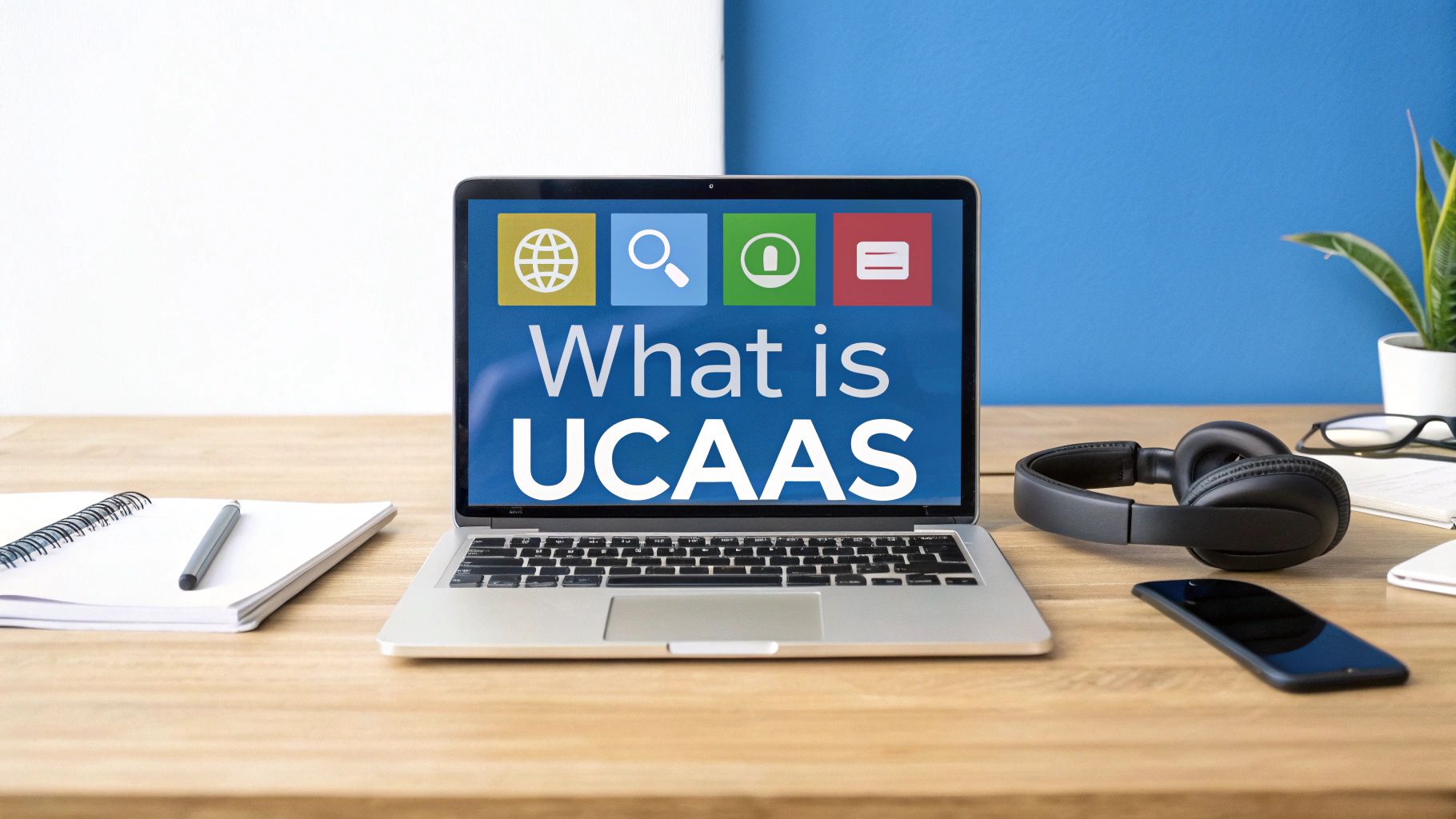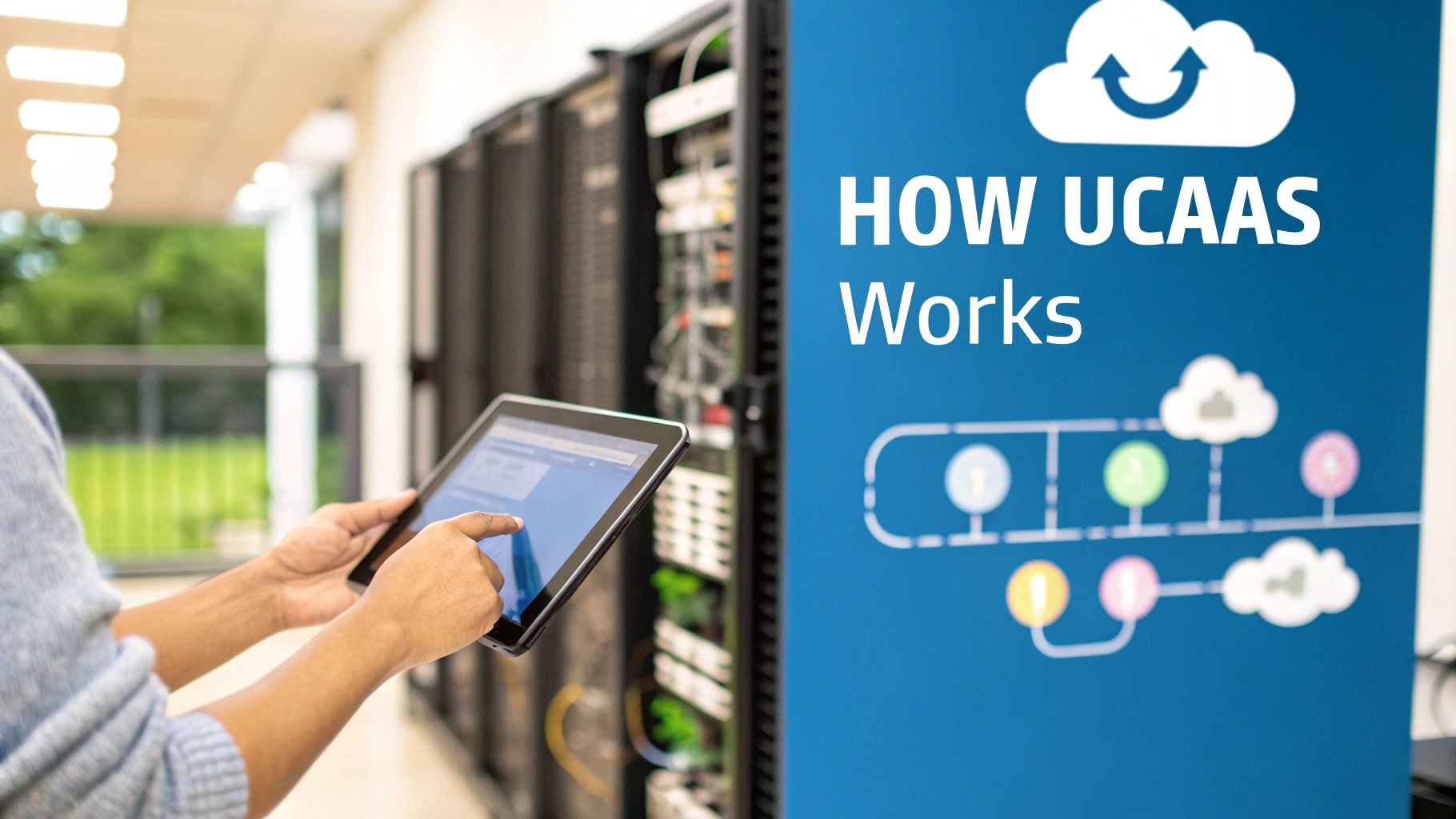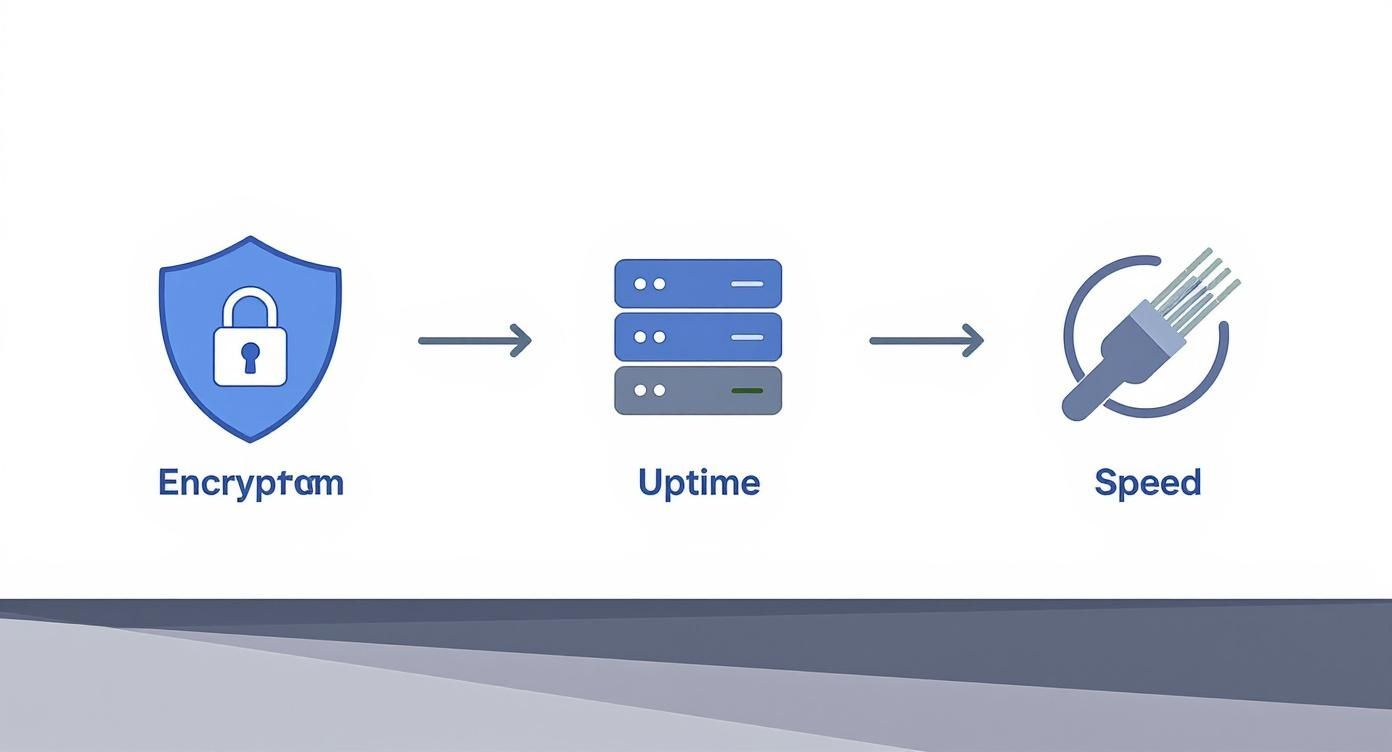Let's get straight to it: what exactly is UCaaS?
Think of Unified Communications as a Service (UCaaS) as the all-in-one command center for your business communications. It’s a cloud-based service that takes all the separate tools you use every day—phone calls, video meetings, and instant messaging—and merges them into a single, streamlined application. Instead of juggling multiple programs, everything you need is right there in one place, delivered over the internet for a predictable subscription fee.
Breaking Down Unified Communications

Imagine your company’s old communication setup was like a messy toolbox. You had a hammer just for phone calls, a separate screwdriver for team chat, and a big wrench for video conferences. Every time you needed to switch tasks, you had to rummage through the box, wasting time and killing momentum. UCaaS gets rid of that clutter and hands you a sleek, powerful Swiss Army knife instead.
The "as a Service" part is what makes it so practical. Gone are the days of buying and maintaining a closet full of expensive, on-premise hardware (like an old-school PBX phone system). With UCaaS, you simply pay a monthly fee to a provider who manages all the technology in the cloud. This trade-off means no more surprise maintenance bills or massive upfront costs.
The Core Idea Behind UCaaS
At its heart, UCaaS is all about creating a completely seamless experience. An employee can start a conversation over chat, decide a call is needed, and then instantly add video and share their screen—all with a single click, inside the same app. It removes the friction that slows teams down, making collaboration feel natural and effortless.
It’s no surprise this model has taken off, especially as more businesses embrace remote and hybrid work. The global UCaaS market was valued at around USD 87.39 billion and is expected to rocket to USD 262.37 billion by 2030. That’s not just growth; it’s a clear signal that companies are leaving outdated, piecemeal systems behind for something better. You can dive deeper into the numbers by checking out the full research about UCaaS market projections.
What's Included in a UCaaS Platform
So what do you actually get with a UCaaS platform? A good solution bundles several powerful tools into one interface that your team can access from their desk phone, computer, or smartphone.
To give you a clearer picture, here’s a quick breakdown of the essentials you can expect to find in a modern UCaaS solution.
Core Components of a UCaaS Platform at a Glance
| Component | Description | Primary Business Use |
|---|---|---|
| Cloud-Based VoIP | A full-featured business phone system delivered over the internet. | Professional call handling with features like auto-attendants and visual voicemail. |
| Video Conferencing | High-definition video meetings with built-in screen sharing and recording. | Face-to-face collaboration with remote team members, clients, and partners. |
| Instant Messaging | Real-time team chat for quick questions, file sharing, and group discussions. | Reducing email overload and speeding up internal decision-making. |
| Presence Indicators | A status icon showing if a colleague is available, busy, or away. | Eliminating guesswork and finding the right time to connect with teammates. |
These core features work together to create a single source of truth for all your communications, empowering your team to stay connected and productive from literally anywhere.
How UCaaS Technology Actually Works

So, what’s really going on behind the scenes with UCaaS? It helps to look under the hood. The whole concept is built on one powerful idea: move all your communication tools into the cloud, managed by a single provider. This completely gets rid of the need for you to buy, update, or even dust off any physical hardware in a server closet.
Think of it like this. An old-school, on-site phone system is like owning a huge collection of DVDs. You have to buy them, find a place to store them all, and deal with it when one gets scratched. UCaaS is more like streaming on Netflix. You just log in and get instant access to a massive library that’s always updated for you, ready to go on any device.
This "as-a-service" approach is what powers modern business communication, giving you access to big-business tools without the big-business headaches.
The Cloud-Native Architecture
At its foundation, every UCaaS platform is built on a cloud-native architecture. This just means the whole system lives in secure, professionally managed data centers scattered across different locations. Your provider takes care of all the tricky stuff—server maintenance, software updates, security, and network backups—freeing up your IT team for more important work.
When one of your employees makes a call, hops on a video meeting, or pings a coworker, that data travels securely over your internet connection to these data centers. The provider’s system handles the request in an instant and connects them to the right person.
This setup offers a couple of huge advantages:
- Reliability: Providers build in layers of backup. If one data center has a problem, your service automatically flips over to another one without missing a beat. This is how they can promise incredibly high uptime, often better than 99.99%.
- Scalability: Need to add a new employee? It’s as easy as updating your subscription online. No more calling a technician to install new phone lines or buying more equipment.
Key Technologies Powering the Platform
A few key technologies work together to make the UCaaS experience feel so seamless. You don't need to be an engineer to use it, but knowing the basics helps you appreciate how everything is connected under one virtual roof.
The big one is Voice over Internet Protocol (VoIP). This is the tech that turns your voice into digital information and sends it over the internet, completely bypassing the old copper phone lines.
At its heart, UCaaS uses VoIP as the engine for its phone services. But it doesn't stop there. It wraps VoIP in a comprehensive suite of tools, transforming a simple calling technology into a complete collaboration hub.
This integration is where the magic happens. For example, Application Programming Interfaces (APIs) act as bridges, letting different software programs talk to each other. A UCaaS platform uses APIs to link its own features with other tools you rely on, like your CRM. A sales rep can then click to call a client right from their CRM contact record, and the system logs the call automatically.
Here are the main pieces and what they do:
- Enterprise-Grade PBX Features: Your provider runs a virtual Private Branch Exchange (PBX) in the cloud. This gives you all the advanced call features like auto-attendants, call queues, and hunt groups, but with zero equipment on-site.
- High-Definition Video and Audio: Smart data compression and routing make sure your video meetings and calls are crystal clear, even if your internet connection isn't perfect.
- Real-Time Presence: The platform keeps everyone’s status in sync. When your manager sets their status to "In a Meeting" on their computer, it instantly shows up that way on your mobile app. No more guessing if it’s a good time to call.
- Integrated Messaging: All your team chats, shared files, and conversation history are stored in the cloud. You can find anything you need, no matter which device you log in from.
By bringing all these elements together, a UCaaS platform creates a single, unified system where every communication channel works together perfectly—all powered by the cloud.
The Business Impact of Adopting UCaaS
So, what does moving to UCaaS actually do for your business? The real value isn't just about getting a new set of tools; it’s about the tangible results a single, unified platform can deliver.
When you switch to UCaaS, you're making a direct and measurable impact on your operations, finances, and overall efficiency. Instead of wrestling with a patchwork of apps that don’t talk to each other, you get one cohesive system. This fundamentally changes how work gets done, turning communication from a daily chore into a strategic advantage that fuels growth.
Driving Down Costs and Boosting Predictability
One of the first things you'll notice with UCaaS is the cost savings. Traditional phone systems mean big upfront investments in hardware like a PBX, not to mention the ongoing costs for maintenance, repairs, and the IT staff needed to manage it all.
UCaaS gets rid of those headaches. Since the entire platform is hosted in the cloud by your provider, there is no expensive hardware to buy or maintain. You just pay a predictable, per-user monthly subscription. This operational expense (OpEx) model makes budgeting a breeze and removes the risk of a surprise repair bill, turning a variable cost into a fixed one.
This is especially valuable for growing businesses. You can accurately forecast your communication expenses without worrying about a huge capital expense every time you need to expand.
Enhancing Team Productivity and Flexibility
A UCaaS platform is a massive boost for productivity. When every tool—voice, video, and messaging—lives in one application, your team wastes less time jumping between different programs. A conversation that starts as a quick chat can become a video call with a single click, keeping work flowing smoothly.
This unified setup is essential for today's work styles.
- For remote and hybrid teams, UCaaS provides the same great experience no matter where an employee is. Everyone gets the same powerful tools, so they can collaborate just as effectively from home as they can from the office.
- Presence indicators show who is available, busy, or offline, cutting down on the time wasted trying to track colleagues down.
- The ability to manage business calls and messages from a mobile app means employees are never chained to their desks, empowering a truly flexible work culture.
The big shift toward remote and hybrid work is a key reason this market is growing so fast. In fact, the U.S. UCaaS market is projected to hit USD 19.97 billion in 2025 and keep growing at a rate of 16.7%.
Achieving Scalability and Improving Customer Experience
Business needs are always changing, and a UCaaS platform is built to scale right alongside you. Adding a new employee is as simple as updating your subscription—no need to order new hardware or wait for a technician. This agility lets you respond quickly to whatever comes your way, whether it's a seasonal hiring rush or opening a new location.
This integration also directly benefits your customers. When all your communication tools work together, you create a much better customer experience (CX). For instance, an integrated contact center can pull customer info from your CRM, giving agents the context they need to solve issues faster. For a closer look at these strategies, resources like a CX leaders' playbook can offer great insights.
Plus, features like intelligent call routing make sure customers reach the right person on the first try. You can also add more channels, like business text messaging, giving customers more ways to get in touch. Check out our guide on how to use VoIP text messaging to see how you can improve engagement. This cohesive approach doesn't just improve efficiency; it elevates your brand's reputation for great service.
UCaaS vs VoIP: Unpacking the Key Differences
In the world of business communications, a lot of terms get thrown around—UCaaS, VoIP, Hosted PBX. It's easy to get them mixed up, but knowing the difference is key to picking the right tools for your company.
While a UCaaS platform relies on VoIP to power its calling features, it’s important to remember that VoIP is just one piece of a much larger puzzle. Think of it as a foundational technology, not the whole solution.
VoIP: The Engine for Modern Calling
Let's use an analogy. VoIP is the engine, but UCaaS is the entire car. The engine is absolutely critical to make the car go, but it can't get you from point A to B all by itself. You still need the steering wheel, seats, and GPS to have a complete, useful vehicle.
That's Voice over Internet Protocol (VoIP) in a nutshell. It's the technology that turns your voice into digital data and sends it over the internet, allowing you to make calls without old-school copper landlines. A standalone VoIP service gives you that engine—a way to make and receive calls online—but that's often where it stops.
The key takeaway is that VoIP is a method of transmission for voice calls. UCaaS is a comprehensive service delivery model that includes VoIP, along with a full suite of other communication and collaboration tools delivered from the cloud.
Hosted PBX: The Cloud-Based Phone System
So, where does a Hosted PBX fit into all this? A Hosted PBX, or cloud PBX, is a big step up from basic VoIP. It takes the core features of a traditional on-site phone system (the kind with a server closet), like auto-attendants, call forwarding, and voicemail, and moves them into the cloud.
This makes it a powerful, phone-first solution. The primary focus, however, is still on one thing: voice communication. While it's a fantastic upgrade from an old PBX, it doesn't really bring other channels like video meetings or team chat into the same unified experience. It’s like having a great car with a powerful engine but no integrated navigation or Bluetooth.
UCaaS: The All-in-One Communication Hub
That brings us to UCaaS, the most complete option of the three. It takes everything from VoIP and Hosted PBX and bundles it with all the other tools your team needs to work together, all in one place.
- Integrated Video Conferencing: Jump into HD video meetings and share your screen without switching apps.
- Team Messaging: Cut down on email clutter with persistent chat channels for projects and teams.
- File Sharing: Securely send and store documents right inside the platform.
- Presence Indicators: Instantly see if your coworkers are available, busy, or away from their desk.
UCaaS weaves all these tools into a single application, creating a smooth, natural workflow. You can go from a quick chat message to a voice call and then to a full video meeting with a single click. That level of deep integration is what sets it apart. It gives you the entire vehicle—engine, navigation, and entertainment system—all controlled from one dashboard.
To learn more about what a modern, integrated calling solution can do for your business, check out our guide on the best internet telephone service.
Comparison of Communication Technologies: UCaaS vs VoIP vs Hosted PBX
To make things even clearer, let's break down how these three technologies stack up side-by-side. It’s easy to see how the services build upon one another, moving from a single function to a complete communications hub.
| Feature | Standalone VoIP | Hosted PBX | UCaaS |
|---|---|---|---|
| Primary Function | Internet-based voice calls | Cloud-based business phone system | All-in-one communication platform |
| Core Offering | Basic calling (make/receive) | Advanced call management features | Voice, video, messaging, collaboration |
| Video Conferencing | Not included | Not typically included | Integrated |
| Team Chat/Messaging | Not included | Not included | Integrated |
| Presence (Status) | Not included | Basic (on a call) | Advanced (available, busy, DND) |
| Integration | Limited to voice | Primarily voice-focused | Fully unified platform |
| Best For | Individuals or basic business lines | Businesses needing a modern phone system | Teams needing seamless collaboration |
Ultimately, while VoIP is the technology that makes internet calling possible, and Hosted PBX modernizes the business phone system, UCaaS is the platform that truly brings it all together for today's connected workplace.
Is It Secure? Is It Reliable? Protecting Your Platform
When you move your entire communication system to the cloud, two big questions immediately come to mind: Is it secure? And will it actually work when we need it most? These are completely fair questions, and any UCaaS provider worth their salt has built their entire service around answering them.
Think of a top-tier UCaaS data center as a digital fortress. It’s a far cry from a dusty server closet in the back office. These facilities are purpose-built with intense physical and digital security, from biometric scanners at the door to sophisticated threat detection systems working 24/7 to keep your data and conversations safe.
Fortifying Your Communications
When you’re on a call discussing sensitive client details or mapping out company strategy, you need absolute certainty that the conversation is private. That's why the best UCaaS platforms rely on end-to-end encryption for all voice, video, and messaging. It's like putting your data in a sealed, tamper-proof envelope the second it leaves your device, only to be opened by the intended recipient.
Beyond just scrambling the data, providers also follow strict compliance rules that are non-negotiable for businesses in certain industries.
- HIPAA: A must-have for any healthcare organization that needs to protect patient information.
- SOC 2: This certification proves a provider has the right systems in place to manage data securely and protect client privacy.
- PCI-DSS: If your business touches credit card information, this standard is essential for keeping that payment data locked down.
A great provider takes a comprehensive approach by implementing strong Information Security Management Systems (ISMS). This isn't just about checking a box for compliance; it's a framework for actively managing and neutralizing security threats day in and day out.
What About Reliability and Uptime?
Security is crucial, but it doesn't mean much if the system is always down. Your phones and collaboration tools are the heartbeat of your business—downtime is not an option. UCaaS providers get this, and they build their networks to be incredibly resilient, backing it up with a formal Service Level Agreement (SLA).
An SLA is basically a contract that guarantees a specific level of performance, especially uptime. You'll often see top providers promising 99.99% uptime or higher. That sounds great, but what does it mean in the real world? It means you can expect less than an hour of potential downtime over an entire year.
How do they pull this off? Through geo-redundancy. Your service isn't just running in one location; it's mirrored across multiple, geographically separate data centers. If a storm or power outage hits one site, your service automatically flips over to a backup center, usually so seamlessly you won't even notice.
Your Network: The Final Piece of the Puzzle
While the provider handles all the heavy lifting in the cloud, there's one critical piece of the puzzle on your end: your internet connection. The performance of your fancy UCaaS platform is only as good as the network it runs on. If you're dealing with jittery calls, frozen video feeds, or laggy messages, the problem is often an unstable internet connection, not the platform itself.
This is where a solid, high-speed connection like fiber internet becomes absolutely essential. Fiber gives you the symmetrical upload and download speeds needed for perfectly clear voice calls and smooth HD video meetings. It has the low latency and high bandwidth to give your team a flawless experience every time.
It's also worth noting that some network settings can accidentally interfere with voice traffic. For a deeper dive, you can learn more about how to fix these issues with what is SIP ALG in our detailed guide.
The shift to cloud services isn't slowing down. By 2025, the hosted segment of the unified communications market is expected to see the highest demand as businesses across healthcare, retail, and more adopt UCaaS to work smarter. A rock-solid fiber foundation is what allows you to truly take advantage of these powerful tools.
Your Step-by-Step Migration Checklist
Making the switch to a UCaaS platform feels like a huge project, but when you break it down into manageable steps, the whole process becomes surprisingly smooth. A successful migration isn't about flipping a switch overnight. It’s about smart, thoughtful planning that sidesteps disruption and gets you the benefits from day one.
This checklist is a clear, proven framework to guide you from your initial homework all the way to a successful rollout. The goal here is to move your business communications to the cloud with confidence, making sure your team is ready and your operations keep running without a single hiccup.
The infographic below highlights the core pillars of any reliable service—encryption, uptime, and speed—which are absolutely critical to think about as you plan your move.

As you can see, a secure and dependable UCaaS experience is built on three things: strong data protection, guaranteed network availability, and a high-speed connection that just works.
Phase 1: Pre-Migration Planning
Before you even start talking to providers, the first step is to look inward. You need a rock-solid understanding of your current setup and what you hope to achieve. This is what helps you choose the right solution later on.
- Assess Your Current Communication Needs: Take an inventory of everything. How many phone lines are you actually using? What’s your average monthly call volume? Which features, like auto-attendants or call recording, are mission-critical for your teams?
- Evaluate Your Network Infrastructure: A UCaaS platform is only as good as the internet it runs on. You need to test your network's bandwidth and stability. We can't stress this enough: a high-speed fiber connection is the best way to guarantee crystal-clear voice and video.
- Define Your Migration Goals: What’s the "why" behind this move? Are you trying to cut costs, make life easier for remote workers, or give your customers a better experience? Having clear goals will help you know if the project was a success.
Phase 2: Provider Selection And Implementation
Once you know what you need, you can find a provider that fits the bill. This phase is all about vetting potential partners and mapping out the technical side of the rollout to avoid any service interruptions.
A key part of this phase is number porting—the process of moving your existing phone numbers to the new service. You'll want to coordinate this carefully with your provider and schedule it during off-hours. Done right, your customers won't notice a thing.
- Choose the Right Provider: Compare your options based on reliability (look for a 99.99% uptime guarantee), security certifications, and the quality of their customer support. Don't just chase a long list of features; find a real partner you can count on.
- Develop a Detailed Implementation Plan: Work with your chosen provider to build a project timeline. This should map out all the key milestones, from the initial setup and number porting to user training and the final go-live date.
- Configure Your New System: Now for the fun part. Set up user accounts, call routing rules, and voicemail boxes. This is where you customize the platform to fit how your business actually works, so it feels natural for your team from the moment they log in.
Phase 3: Post-Migration And Optimization
The job isn't done just because the system is live. This final phase is all about making sure your team actually adopts the new tools and that the platform keeps evolving with your business. This is where you turn a technical success into a long-term win.
- Train Your Team: Host a few training sessions to walk employees through the new platform. Focus on the features that will make their jobs easier, not just the technical jargon.
- Gather Feedback: Once everyone has had a chance to use it, actively ask for feedback. What’s working well? Are there any pain points? Use this input to make small, helpful adjustments.
- Monitor and Optimize: Keep an eye on the usage analytics. Are there powerful features that nobody is using? Are call queues getting too long during peak hours? Use this data to fine-tune your setup and get the most out of your investment.
Got Questions About UCaaS? We've Got Answers.
Let's wrap things up by tackling a few of the most common questions businesses ask when they start exploring UCaaS. Here are some straightforward answers to help you see how it all fits together.
What Does UCaaS Usually Cost?
Forget about the huge upfront cost of a traditional phone system. UCaaS works on a simple subscription model, so you just pay a flat monthly fee per user, per month.
This approach gets rid of surprise repair bills and makes your budget predictable. The final price tag depends on the features you choose, but the bottom line is that it turns a major capital expense into a manageable operating cost. This makes top-tier communication tools affordable for any business, big or small.
Can I Keep My Current Phone Numbers?
Yes, absolutely. This is a big concern for most businesses, but the whole process is surprisingly smooth. It’s done through something called number porting, where your new UCaaS provider works directly with your old phone company to move your existing numbers over.
This is a standard, everyday procedure. When it's planned right, there's zero downtime. Your customers won't notice a thing, keeping your business running without a hitch.
Being able to keep your established phone numbers is non-negotiable for a UCaaS switch. It protects the brand identity you've worked hard to build and saves you the massive headache of updating your contact info on every website, business card, and customer file.
Is UCaaS Too Complicated for a Small Business to Handle?
Not at all—in fact, it's built to be the exact opposite. One of the best things about UCaaS is how simple it is. The provider takes care of all the complicated stuff for you—the servers, the security updates, all the backend maintenance.
You get a clean, easy-to-use web portal to manage everything yourself. From that single dashboard, you can add a new employee, change how calls are routed, or check usage reports without needing an IT person on standby. It gives small businesses total control over their phone system.
A great communication platform needs a great network to run on. Premier Broadband delivers the high-speed, 100% fiber internet and VoIP services that make sure your UCaaS system provides crystal-clear calls and perfect video. Upgrade your business connectivity today.




